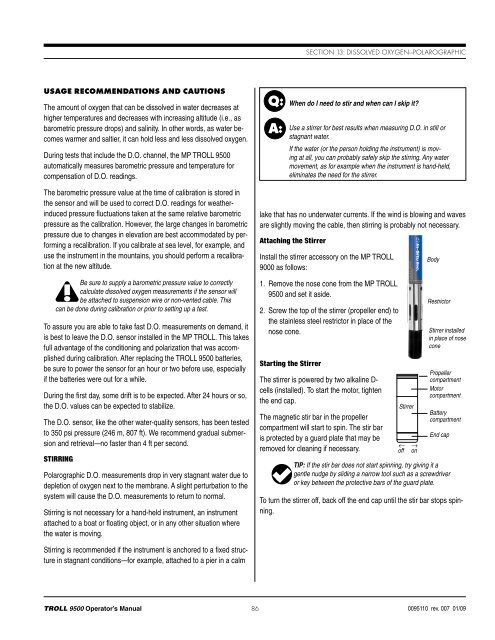TROLL 9500 Operator's Manual - Geotech Environmental Equipment
TROLL 9500 Operator's Manual - Geotech Environmental Equipment
TROLL 9500 Operator's Manual - Geotech Environmental Equipment
You also want an ePaper? Increase the reach of your titles
YUMPU automatically turns print PDFs into web optimized ePapers that Google loves.
Section 13: Dissolved Oxygen—PolarographicUsage Recommendations and CautionsThe amount of oxygen that can be dissolved in water decreases athigher temperatures and decreases with increasing altitude (i.e., asbarometric pressure drops) and salinity. In other words, as water becomeswarmer and saltier, it can hold less and less dissolved oxygen.During tests that include the D.O. channel, the MP <strong>TROLL</strong> <strong>9500</strong>automatically measures barometric pressure and temperature forcompensation of D.O. readings.The barometric pressure value at the time of calibration is stored inthe sensor and will be used to correct D.O. readings for weatherinducedpressure fluctuations taken at the same relative barometricpressure as the calibration. However, the large changes in barometricpressure due to changes in elevation are best accommodated by performinga recalibration. If you calibrate at sea level, for example, anduse the instrument in the mountains, you should perform a recalibrationat the new altitude.Be sure to supply a barometric pressure value to correctlycalculate dissolved oxygen measurements if the sensor willbe attached to suspension wire or non-vented cable. Thiscan be done during calibration or prior to setting up a test.To assure you are able to take fast D.O. measurements on demand, itis best to leave the D.O. sensor installed in the MP <strong>TROLL</strong>. This takesfull advantage of the conditioning and polarization that was accomplishedduring calibration. After replacing the <strong>TROLL</strong> <strong>9500</strong> batteries,be sure to power the sensor for an hour or two before use, especiallyif the batteries were out for a while.During the first day, some drift is to be expected. After 24 hours or so,the D.O. values can be expected to stabilize.The D.O. sensor, like the other water-quality sensors, has been testedto 350 psi pressure (246 m, 807 ft). We recommend gradual submersionand retrieval—no faster than 4 ft per second.StirringPolarographic D.O. measurements drop in very stagnant water due todepletion of oxygen next to the membrane. A slight perturbation to thesystem will cause the D.O. measurements to return to normal.Stirring is not necessary for a hand-held instrument, an instrumentattached to a boat or floating object, or in any other situation wherethe water is moving.Q:A:When do I need to stir and when can I skip it?Use a stirrer for best results when measuring D.O. in still orstagnant water.If the water (or the person holding the instrument) is movingat all, you can probably safely skip the stirring. Any watermovement, as for example when the instrument is hand-held,eliminates the need for the stirrer.lake that has no underwater currents. If the wind is blowing and wavesare slightly moving the cable, then stirring is probably not necessary.Attaching the StirrerInstall the stirrer accessory on the MP <strong>TROLL</strong>9000 as follows:1. Remove the nose cone from the MP <strong>TROLL</strong><strong>9500</strong> and set it aside.2. Screw the top of the stirrer (propeller end) tothe stainless steel restrictor in place of thenose cone.Starting the StirrerThe stirrer is powered by two alkaline D-cells (installed). To start the motor, tightenthe end cap.The magnetic stir bar in the propellercompartment will start to spin. The stir baris protected by a guard plate that may beremoved for cleaning if necessary.Stirrer← →off onBodyRestrictorStirrer installedin place of noseconePropellercompartmentMotorcompartmentBatterycompartmentEnd capTIP: If the stir bar does not start spinning, try giving it agentle nudge by sliding a narrow tool such as a screwdriveror key between the protective bars of the guard plate.To turn the stirrer off, back off the end cap until the stir bar stops spinning.Stirring is recommended if the instrument is anchored to a fixed structurein stagnant conditions—for example, attached to a pier in a calm<strong>TROLL</strong> <strong>9500</strong> Operator’s <strong>Manual</strong> 860095110 rev. 007 01/09
















